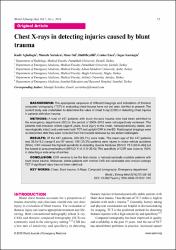Chest X-rays in detecting injuries caused by blunt trauma
Abstract
BACKGROUND: The appropriate sequence of different imagings and indications of thoracic computed tomography (TCT) in evaluating chest trauma have not yet been clarified at present. The current study was undertaken to determine the value of chest X-ray (CXR) in detecting chest injuries in patients with blunt trauma. METHODS: A total of 447 patients with blunt thoracic trauma who had been admitted to the emergency department (ED) in the period of 2009-2013 were retrospectively reviewed. The patients met inclusion criteria (age>8 years, blunt injury to the chest, hemodynamically stable, and neurologically intact) and underwent both TCT and upright CXR in the ED. Radiological imagings were re-interpreted after they were collected from the hospital database by two skilled radiologists. RESULTS: Of the 447 patients, 309 (69.1%) were male. The mean age of the 447 patients was 39.5+/-19.2 (range 9 and 87 years). 158 (35.3%) patients were injured in motor vehicle accidents (MVA). CXR showed the highest sensitivity in detecting clavicle fractures [95%CI 78.3 (63.6-89)] but the lowest in pneuomediastinum [95%CI 11.8 (1.5-36.4)]. The specificity of CXR was close to 100% in detecting a wide array of entities. CONCLUSION: CXR remains to be the first choice in hemodynamically unstable patients with blunt chest trauma. Moreover, stable patients with normal CXR are candidates who should undergo TCT if significant injury has not been ruled out.
Source
World Journal of Emergency MedicineVolume
7Issue
1URI
https://hdl.handle.net/20.500.12809/2705https://www.ncbi.nlm.nih.gov/pmc/articles/PMC4786501/pdf/WJEM-7-55.pdf


















